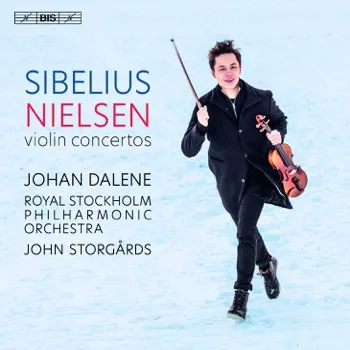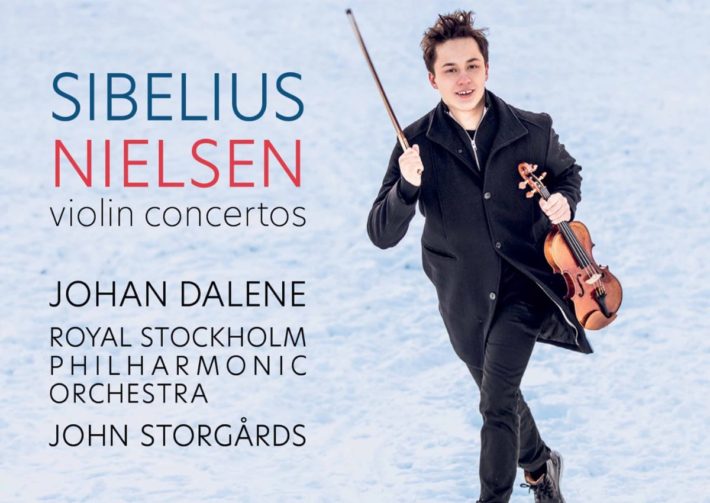In 2020, I reviewed Johan Dalene’s performance of the Tchaikovsky and Barber violin concertos and remarked that his debut held up to a high standard given the ambitious program. His sophomore album, this time with the Royal Stockholm Philharmonic, features concertos by Nordic composers. The inclusion of the Nielsen echoes back to his win at the 2019 Nielsen Violin Competition, where he performed the work in the final round. The Sibelius mirrors the prior Tchaikovsky as another significantly popular–and challenging–concerto.

Carl Nielsen’s only violin concerto (1911) shares a commonality with works like his flute concerto and fifth symphony where form is concerned: 2 movements each divided into 2 sections. The furious cadenza of the Praeludium (track 1) thrusts the violin into the limelight straightaway. It’s nice to hear how Dalene really goes for it (and why shouldn’t he with his level of technical mastery?). This boldness also sets up a dynamic and unexpected shift in character when G major arrives (1:40).
There’s imagination aplenty from the performers at this point, as they paint a pastel, idyllic scene. Dalene casts a youthful and almost dreamy light on the violin’s phrases by way of some nice tone control. The Allegro cavalleresco (track 2) is unique and descriptive for a tempo marking: the orchestra, balanced and resonant, portrays the indicated ‘chivalrous’ quality with a dignified but still buoyant character. Dalene’s portrayal of the thematic material adds that extra bit of welcome flair.
In the Rondo (track 4), Nielsen’s creative use of chromaticism evokes an eccentric joviality. Dalene’s fluidity in the way he plays the melody creates a humorous scene of slipping and sliding–a touch more extroverted but as equally enjoyable as the account by Cho-Liang Lin and Esa-Pekka Salonen (1989). The cadenza by nature of its writing is a bit disjointed in my opinion, but offers the perfect opportunity for the soloist to show off an array of skills, including trills and simultaneous arco and pizzicatos. Dalene does not disappoint in this regard.
Much like in the Nielsen, Dalene handles the technical demands of the Sibelius with aplomb: the runs and glittering arpeggios showcase pristine articulation and faultless intonation. In terms of character, the Sibelius is something of an antithesis to the Nielsen–darker and more serious, as one hears in the Allegro Moderato (track 5). The movement calls for the performer’s close attention to expressive subtleties, and Dalene’s opening says a lot about how he approaches the movement as a whole. The theme, whispery yet beckoning, is a faraway voice that calls to the listener.
As for the more complex passages, they still manage to maintain beautiful nuance amidst the virtuosity. Dalene’s artistic choices are interestingly different from the much loved Heifetz recording (1935) with Sir Thomas Beecham. I found Heifetz decidedly more declamatory from the outset: parts of the theme are reminiscent of a poignant wail and effectively foreshadow a fiery and emphatic take on the movement. For all the subtlety, however, Dalene doesn’t let the lush moments escape their full glory: the iconic theme at 3:56 is sweeping, romantic, and even urgently impassioned.
The second movement continues on the path of nuance and balance. The airy timbre and inquisitive introductory dialogue between the orchestral winds finds its answer in the violin’s theme, which is contemplative and poetic. Dalene throughout exhibits a sensitive understanding of both the instrument’s capacities and the rich vocal quality of the lines. His soothing blend of huskiness and warmth especially in the lower tones is highly responsive to the composer’s striking harmonic color changes.
The Allegro ma Tanto (track 7) is nothing short of an adventure for listener and performer alike, with the soloist making lithe, acrobatic shifts between registers. Although the orchestra plays more of a background role here, the Royal Stockholm’s timpanis in particular do a nice job adding subtle hints of suspense.
Philip Borg-Wheeler’s liner notes are well-written: they touch upon key musical and elemental structures in each concerto and serve as a helpful guide through both works. The hybrid SACD format, as it does in other BIS recordings, gives us a lovely feature of both soloist and orchestra but does especially well in bringing out the violinist’s excellent attention to detail. This is an impressive follow up to an already successful debut and cements Dalene’s place as an artist of greatest promise.
Sibelius and Nielsen – Violin Concertos
Johan Dalene – Violin
Royal Stockholm Philharmonic Orchestra
John Storgårds – Conductor
BIS Records, SACD Hybrid BIS-2620




















